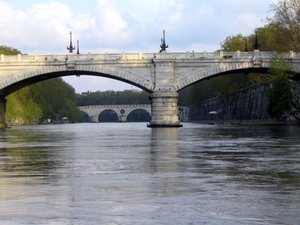Tiber
|
|
The River Tiber (Italian Tevere), the third-longest river in Italy (disputed — see talk page) at 406 km (252 miles) after the Po and the Adige, flows through Rome in its course from Mount Fumaiolo to the Tyrrhenian Sea, which it reaches in two branches that cross the suburbs of Ostia-Isola Sacra (south) and Fiumicino (north). The Tiber drains a basin estimated at 18,000 km² (6845 square miles).
It is probable that the name 'Tiber' is pre-Latin, like the Roman name of Tibur (modern Tivoli). A mythic king Tiberinus, ninth in the legendary king-list of Alba Longa, was said to have drowned in the Albula river, which was subsequently renamed the Tiber. The myth explained a memory of an earlier, probably pre-Indo-European, name for the river, 'white' with sediment. Legend says Rome's founders, the twin brothers Romulus and Remus, were abandoned on its waters, where they were rescued by a she-wolf. See founding of Rome.
The Tiber has been an important river in trade and commerce since the days of the Punic Wars, during which the harbor at Ostia became a key naval base. As the Ostia harbor silted up, a new road, the via Portuense, was built at the end of the 1st century CE, to connect Rome with the new Imperial port, Fiumicino, leaving the city by Porta Portese ('the port gate').
The Tiber receives another important Roman stream, the Anio, and has an island (Isola Tiberina) in the center of Rome, between Trastevere and the ancient center. The ford at the island was probably the most ancient settlement of the city.
Tiber_vatican.jpg
Popularly called flavus, "the blonde river", the Tiber is heavily charged with sediment but does not form a proportionable delta, owing to a strong north-flowing sea current close to the shore, to the steep shelving of the coast, and to slow tectonic subsidence. The coastline has advanced at each mouth about 3 km (2 miles) since Roman times, leaving the remains of ancient Ostia inland. A century ago, the rate of advance at Fiumicino was estimated at 4 m (13 ft) per year.
The arm which reaches the sea at Fiumicino is a canal, which was dug in the reign of the Emperor Claudius and improved by Trajan. It silted up during the Middle Ages enough to be useless for barges, but was reopened for navigation by Pope Paul V in 1612.
Ancient Romans connected the river with a sewer system (the Cloaca Maxima) and with an underground net of tunnels and other channels, to bring its water into the middle of the town. The modern stone embankments were begun in 1876.
Floods of the Tiber have affected the course of history. In modern times, famous floods occurred in 1598, 1870 and 1900.
Benito Mussolini, born in Romagna, adjusted the boundary between Tuscany and Emilia-Romagna, so that the springs of the Tiber would lie in Romagna. By the limpid spring was erected an antique Roman column, inscribed QUI NASCE IL TEVERE SACRO AI DESTINI DI ROMA ("Here is born the Tiber, sacred to the destinies of Rome")
Tiberium, a fictional life form from the Command and Conquer series of computer games, is named after the Tiber river, near which it was first discovered.
When an Anglican converts to Roman Catholicism, that person is said to have "swum the Tiber". The reverse is referred to as "swimming the Thames".bg:Тибър de:Tiber es:Tíber fr:Tibre it:Tevere he:טיבר la:Tiberis nl:Tiber ja:テヴェレ川 no:Tiberen pl:Tyber pt:Rio Tibre sl:Tibera sv:Tibern

